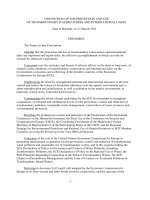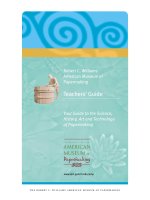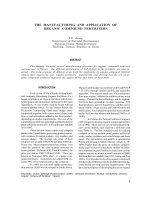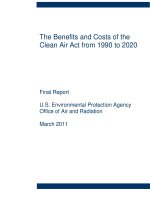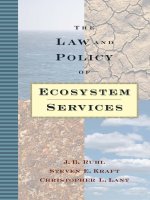The chemistry and technology of petroleum
Bạn đang xem bản rút gọn của tài liệu. Xem và tải ngay bản đầy đủ của tài liệu tại đây (15.86 MB, 942 trang )
FIFTH EDITION
The Chemistry
and Technology
of Petroleum
CHEMICAL INDUSTRIES
A Series of Reference Books and Textbooks
Founding Editor
HEINZ HEINEMANN
Berkeley, California
Series Editor
JAMES G. SPEIGHT
CD & W, Inc.
Laramie, Wyoming
MOST RECENTLy PUbLISHED
The Chemistry and Technology of Petroleum, Fifth Edition, James G. Speight
Refining Used Lubricating Oils, James Speight and Douglas I. Exall
Educating Scientists and Engineers for Academic and Non-Academic Career
Success, James Speight
Transport Phenomena Fundamentals, Third Edition, Joel Plawsky
Synthetics, Mineral Oils, and Bio-Based Lubricants: Chemistry and Technology,
Second Edition, Leslie R. Rudnick
Modeling of Processes and Reactors for Upgrading of Heavy Petroleum,
Jorge Ancheyta
Synthetics, Mineral Oils, and Bio-Based Lubricants: Chemistry and Technology,
Second Edition, Leslie R. Rudnick
Fundamentals of Automatic Process Control, Uttam Ray Chaudhuri and
Utpal Ray Chaudhuri
The Chemistry and Technology of Coal, Third Edition, James G. Speight
Practical Handbook on Biodiesel Production and Properties, Mushtaq Ahmad,
Mir Ajab Khan, Muhammad Zafar, and Shazia Sultana
Introduction to Process Control, Second Edition, Jose A. Romagnoli
and Ahmet Palazoglu
Fundamentals of Petroleum and Petrochemical Engineering, Uttam Ray Chaudhuri
Advances in Fluid Catalytic Cracking: Testing, Characterization, and
Environmental Regulations, edited by Mario L. Occelli
Advances in Fischer-Tropsch Synthesis, Catalysts, and Catalysis,
edited by Burton H. Davis and Mario L. Occelli
Transport Phenomena Fundamentals, Second Edition, Joel Plawsky
Asphaltenes: Chemical Transformation during Hydroprocessing of Heavy Oils,
Jorge Ancheyta, Fernando Trejo, and Mohan Singh Rana
Chemical Reaction Engineering and Reactor Technology, Tapio O. Salmi,
Jyri-Pekka Mikkola, and Johan P. Warna
CHEMICAL INDUSTRIES/137
FIFTH EDITION
The Chemistry
and Technology
of Petroleum
Ja m es G. Sp e i g h t
Boca Raton London New York
CRC Press is an imprint of the
Taylor & Francis Group, an informa business
CRC Press
Taylor & Francis Group
6000 Broken Sound Parkway NW, Suite 300
Boca Raton, FL 33487-2742
© 2014 by Taylor & Francis Group, LLC
CRC Press is an imprint of Taylor & Francis Group, an Informa business
No claim to original U.S. Government works
Version Date: 20130712
International Standard Book Number-13: 978-1-4398-7390-8 (eBook - PDF)
This book contains information obtained from authentic and highly regarded sources. Reasonable efforts have been
made to publish reliable data and information, but the author and publisher cannot assume responsibility for the validity of all materials or the consequences of their use. The authors and publishers have attempted to trace the copyright
holders of all material reproduced in this publication and apologize to copyright holders if permission to publish in this
form has not been obtained. If any copyright material has not been acknowledged please write and let us know so we may
rectify in any future reprint.
Except as permitted under U.S. Copyright Law, no part of this book may be reprinted, reproduced, transmitted, or utilized in any form by any electronic, mechanical, or other means, now known or hereafter invented, including photocopying, microfilming, and recording, or in any information storage or retrieval system, without written permission from the
publishers.
For permission to photocopy or use material electronically from this work, please access www.copyright.com (http://
www.copyright.com/) or contact the Copyright Clearance Center, Inc. (CCC), 222 Rosewood Drive, Danvers, MA 01923,
978-750-8400. CCC is a not-for-profit organization that provides licenses and registration for a variety of users. For
organizations that have been granted a photocopy license by the CCC, a separate system of payment has been arranged.
Trademark Notice: Product or corporate names may be trademarks or registered trademarks, and are used only for
identification and explanation without intent to infringe.
Visit the Taylor & Francis Web site at
and the CRC Press Web site at
Contents
Preface.......................................................................................................................................... xxiii
Author.............................................................................................................................................xxv
Section I History, Occurrence, and Recovery
Chapter 1 History and Terminology.............................................................................................. 3
1.1
1.2
1.3
1.4
Historical Perspectives.......................................................................................3
Modern Perspectives.......................................................................................... 9
Definitions and Terminology............................................................................ 12
Native Materials............................................................................................... 14
1.4.1Petroleum............................................................................................ 14
1.4.2 Opportunity Crudes and High-Acid Crudes....................................... 15
1.4.3 Heavy Oil............................................................................................ 16
1.4.4 Foamy Oil............................................................................................ 16
1.4.5 Extra Heavy Oil................................................................................... 17
1.4.6Bitumen............................................................................................... 17
1.4.7Wax...................................................................................................... 18
1.4.8 Asphaltite and Asphaltoid................................................................... 18
1.4.9 Bituminous Rock and Bituminous Sand............................................. 19
1.4.10Kerogen...............................................................................................20
1.4.11 Natural Gas.........................................................................................20
1.5 Manufactured Materials................................................................................... 22
1.5.1Wax...................................................................................................... 22
1.5.2Resid.................................................................................................... 22
1.5.3Asphalt................................................................................................ 23
1.5.4 Tar and Pitch....................................................................................... 23
1.5.5Coke.....................................................................................................24
1.5.6 Synthetic Crude Oil.............................................................................24
1.6 Derived Materials.............................................................................................24
1.6.1 Asphaltenes, Carbenes, and Carboids.................................................24
1.6.2 Resins and Oils....................................................................................25
1.7 Oil Prices..........................................................................................................26
1.7.1 Pricing Strategies................................................................................26
1.7.2 Oil Price History................................................................................. 27
1.7.3 Future of Oil........................................................................................28
1.7.4Epilogue..............................................................................................28
References...................................................................................................................28
Chapter 2 Classification............................................................................................................... 31
2.1Introduction...................................................................................................... 31
2.2 Classification Systems...................................................................................... 32
2.2.1 Classification as a Hydrocarbon Resource.......................................... 32
2.2.2 Classification by Chemical Composition............................................34
2.2.3 Correlation Index................................................................................. 35
v
vi
Contents
2.2.4Density................................................................................................ 36
2.2.5 API Gravity........................................................................................ 37
2.2.6Viscosity............................................................................................. 38
2.2.7 Carbon Distribution............................................................................ 38
2.2.8 Viscosity-Gravity Constant................................................................ 38
2.2.9 UOP Characterization Factor............................................................. 39
2.2.10 Recovery Method............................................................................... 39
2.2.11 Pour Point...........................................................................................40
2.3 Miscellaneous Systems..................................................................................... 41
2.4 Reservoir Classification.................................................................................... 42
2.4.1 Identification and Quantification........................................................ 42
2.4.2Future..................................................................................................44
References...................................................................................................................44
Chapter 3 Origin and Occurrence................................................................................................ 47
3.1Introduction...................................................................................................... 47
3.2Origin............................................................................................................... 47
3.2.1 Abiogenic Origin................................................................................ 48
3.2.2 Biogenic Origin.................................................................................. 49
3.2.2.1 Deposition of Organic Matter............................................. 51
3.2.2.2 Establishment of Source Beds............................................ 51
3.2.2.3 Nature of the Source Material............................................ 53
3.2.2.4 Transformation of Organic Matter into Petroleum............. 55
3.2.2.5 Accumulation in Reservoir Sediments............................... 57
3.2.2.6 In Situ Transformation of Petroleum.................................. 61
3.2.3 Differences between Abiogenic Theory and Biogenic Theory..........64
3.2.4 Relationship of Petroleum Composition and Properties.................... 65
3.3Occurrence....................................................................................................... 67
3.3.1Reserves.............................................................................................. 67
3.3.2 Conventional Petroleum..................................................................... 70
3.3.3 Natural Gas......................................................................................... 71
3.3.4 Heavy Oil........................................................................................... 72
3.3.5Bitumen.............................................................................................. 73
References................................................................................................................... 75
Chapter 4 Reservoirs and Reservoir Fluids................................................................................. 79
4.1Introduction...................................................................................................... 79
4.2Reservoirs......................................................................................................... 79
4.2.1 Structural Types.................................................................................80
4.2.2Heterogeneity...................................................................................... 81
4.3 Classes of Fluids............................................................................................... 82
4.4 Evaluation of Reservoir Fluids......................................................................... 83
4.4.1 Sampling Methods..............................................................................84
4.4.2 Data Acquisition and QA/QC............................................................. 85
4.5 Physical Composition and Molecular Weight.................................................. 87
4.5.1 Asphaltene Separation........................................................................ 87
4.5.2Fractionation....................................................................................... 89
4.5.3 Molecular Weight............................................................................... 91
4.6 Reservoir Evaluation........................................................................................ 95
References...................................................................................................................96
Contents
vii
Chapter 5 Kerogen.......................................................................................................................99
5.1Introduction......................................................................................................99
5.2Properties..........................................................................................................99
5.3Composition.................................................................................................... 102
5.4Classification.................................................................................................. 102
5.5Isolation.......................................................................................................... 104
5.6 Methods for Probing Kerogen Structure........................................................ 104
5.6.1 Ultimate (Elemental) Analysis.......................................................... 104
5.6.2 Functional Group Analysis............................................................... 105
5.6.3Oxidation........................................................................................... 105
5.6.4 Thermal Methods.............................................................................. 106
5.6.5 Acid-Catalyzed Hydrogenolysis........................................................ 107
5.7 Structural Models........................................................................................... 107
5.8 Kerogen Maturation........................................................................................ 109
References................................................................................................................. 111
Chapter 6 Exploration, Recovery, and Transportation............................................................... 115
6.1Introduction.................................................................................................... 115
6.2Exploration..................................................................................................... 116
6.2.1 Gravity Methods................................................................................ 117
6.2.2 Magnetic Methods............................................................................. 118
6.2.3 Seismic Methods............................................................................... 119
6.2.4 Electrical Methods............................................................................ 119
6.2.5 Electromagnetic Methods................................................................. 120
6.2.6 Radioactive Methods......................................................................... 120
6.2.7 Borehole Logging.............................................................................. 120
6.3Drilling........................................................................................................... 121
6.3.1 Preparing to Drill.............................................................................. 121
6.3.2 Drilling Equipment........................................................................... 122
6.3.3 Drilling Rig....................................................................................... 124
6.3.4Drilling.............................................................................................. 125
6.4 Well Completion............................................................................................. 125
6.5Recovery......................................................................................................... 126
6.5.1 Primary Recovery............................................................................. 128
6.5.2 Secondary Recovery......................................................................... 130
6.5.3 Enhanced Oil Recovery.................................................................... 132
6.6 Products and Product Quality........................................................................ 141
6.7Transportation................................................................................................ 142
References................................................................................................................. 147
Chapter 7 Recovery of Heavy Oil and Tar Sand Bitumen......................................................... 149
7.1Introduction.................................................................................................... 149
7.2Mining............................................................................................................ 153
7.2.1 Tar Sand Mining............................................................................... 154
7.2.2 Hot-Water Process............................................................................. 156
7.2.3 Other Processes................................................................................. 158
7.3 Nonmining Methods....................................................................................... 160
7.3.1 Steam-Based Processes..................................................................... 161
7.3.2 Combustion Processes....................................................................... 162
7.3.3 Other Processes................................................................................. 165
viii
Contents
7.4
Upgrading during Recovery........................................................................... 173
7.4.1 Partial Upgrading at the Surface....................................................... 174
7.4.1.1 Thermal Cracking Processes............................................. 175
7.4.1.2 Solvent Processes............................................................... 176
7.4.2 Upgrading during In Situ Recovery.................................................. 176
7.4.2.1 Steam Distillation.............................................................. 177
7.4.2.2 Mild Thermal Cracking..................................................... 177
7.4.2.3 Partial Combustion............................................................ 178
7.4.2.4 Solvent Deasphalting......................................................... 180
7.4.2.5 Microbial Enhanced Oil Recovery.................................... 181
7.4.3Epilogue............................................................................................ 181
References................................................................................................................. 182
Section II Composition and Properties
Chapter 8 Chemical Composition.............................................................................................. 187
8.1Introduction.................................................................................................... 187
8.2 Ultimate (Elemental) Composition................................................................ 188
8.3 Chemical Composition................................................................................... 189
8.3.1 Hydrocarbon Components................................................................. 190
8.3.1.1 Paraffin Hydrocarbons....................................................... 191
8.3.1.2 Cycloparaffin Hydrocarbons (Naphthenes)....................... 193
8.3.1.3 Aromatic Hydrocarbons.................................................... 194
8.3.1.4 Unsaturated Hydrocarbons................................................ 196
8.3.2 Nonhydrocarbon Components........................................................... 196
8.3.2.1 Sulfur Compounds............................................................. 197
8.3.2.2 Oxygen Compounds.......................................................... 198
8.3.2.3 Nitrogen Compounds......................................................... 199
8.3.2.4 Metallic Constituents......................................................... 201
8.3.2.5Porphyrins..........................................................................202
8.4 Chemical Composition by Distillation........................................................... 203
8.4.1 Gases and Naphtha............................................................................205
8.4.2 Middle Distillates..............................................................................206
8.4.3 Vacuum Residua (1050°F+)................................................................208
References.................................................................................................................208
Chapter 9 Fractional Composition............................................................................................. 211
9.1Introduction.................................................................................................... 211
9.2Distillation...................................................................................................... 212
9.2.1 Atmospheric Pressure........................................................................ 216
9.2.2 Reduced Pressures............................................................................. 216
9.2.3 Azeotropic and Extractive Distillation.............................................. 218
9.3 Solvent Treatment........................................................................................... 219
9.3.1 Asphaltene Separation....................................................................... 221
9.3.1.1 Influence of Solvent Type................................................. 221
9.3.1.2 Influence of the Degree of Dilution..................................224
Contents
ix
9.3.1.3 Influence of Temperature................................................224
9.3.1.4 Influence of Contact Time..............................................224
9.3.2Fractionation................................................................................... 225
9.4Adsorption...................................................................................................... 227
9.4.1
Chemical Factors............................................................................ 227
9.4.2
Fractionation Methods.................................................................... 228
9.4.2.1 General Methods............................................................. 228
9.4.2.2 ASTM Methods.............................................................. 231
9.5 Chemical Methods.......................................................................................... 233
9.5.1
Acid Treatment............................................................................... 233
9.5.2
Molecular Complex Formation...................................................... 235
9.5.2.1 Urea Adduction............................................................... 235
9.5.2.2 Thiourea Adduction........................................................ 236
9.5.2.3 Adduct Composition....................................................... 236
9.5.2.4 Adduct Structure............................................................. 237
9.5.2.5 Adduct Properties........................................................... 237
9.6 Use of the Data............................................................................................... 238
References.................................................................................................................240
Chapter 10 Petroleum Analysis.................................................................................................... 243
10.1Introduction.................................................................................................... 243
10.2 Petroleum Assay............................................................................................. 243
10.3 Physical Properties.........................................................................................246
10.3.1 Elemental (Ultimate) Analysis.......................................................246
10.3.2 Density and Specific Gravity.......................................................... 247
10.3.3Viscosity......................................................................................... 249
10.3.4 Surface and Interfacial Tension...................................................... 251
10.3.5 Metal Content................................................................................. 253
10.3.6 Total Acid Number......................................................................... 254
10.4 Thermal Properties......................................................................................... 254
10.4.1Volatility......................................................................................... 255
10.4.2 Liquefaction and Solidification...................................................... 258
10.4.3 Carbon Residue..............................................................................260
10.4.4 Aniline Point.................................................................................. 261
10.4.5 Specific Heat................................................................................... 261
10.4.6 Latent Heat..................................................................................... 262
10.4.7 Enthalpy or Heat Content............................................................... 262
10.4.8 Thermal Conductivity.................................................................... 262
10.4.9 Pressure–Volume–Temperature Relationships............................... 263
10.4.10 Heat of Combustion........................................................................ 263
10.4.11 Critical Properties...........................................................................264
10.5 Electrical Properties.......................................................................................264
10.5.1Conductivity...................................................................................264
10.5.2 Dielectric Constant.........................................................................264
10.5.3 Dielectric Strength.......................................................................... 265
10.5.4 Dielectric Loss and Power Factor................................................... 265
10.5.5 Static Electrification.......................................................................266
10.6 Optical Properties..........................................................................................266
10.6.1 Refractive Index.............................................................................266
10.6.2 Optical Activity.............................................................................. 267
x
Contents
10.7
Spectroscopic Methods................................................................................. 268
10.7.1 Infrared Spectroscopy..................................................................... 269
10.7.2 Nuclear Magnetic Resonance.......................................................... 269
10.7.3 Mass Spectrometry.......................................................................... 269
10.8 Chromatographic Methods........................................................................... 270
10.8.1 Gas Chromatography....................................................................... 270
10.8.2 Simulated Distillation...................................................................... 273
10.8.3 Adsorption Chromatography........................................................... 274
10.8.4 Gel Permeation Chromatography.................................................... 275
10.8.5 Ion-Exchange Chromatography....................................................... 276
10.8.6 High-Performance Liquid Chromatography................................... 277
10.8.7 Supercritical Fluid Chromatography............................................... 278
10.9 Molecular Weight......................................................................................... 278
10.10 Use of the Data............................................................................................. 279
References.................................................................................................................280
Chapter 11 Structural Group Analysis......................................................................................... 283
11.1Introduction.................................................................................................. 283
11.2 Methods for Structural Group Analysis....................................................... 285
11.2.1 Physical Property Methods.............................................................. 288
11.2.1.1 Direct Method.................................................................. 288
11.2.1.2 Waterman Ring Analysis.................................................. 290
11.2.1.3 Density Method................................................................ 291
11.2.1.4 n–d–M Method................................................................. 291
11.2.1.5 Dispersion–Refraction Method........................................ 292
11.2.1.6 Density–Temperature Coefficient Method....................... 292
11.2.1.7 Molecular Weight–Refractive Index Method................... 293
11.2.1.8 Miscellaneous Methods.................................................... 293
11.2.2 Spectroscopic Methods.................................................................... 295
11.2.2.1 Infrared Spectroscopy...................................................... 295
11.2.2.2 Nuclear Magnetic Resonance Spectroscopy.................... 299
11.2.2.3 Mass Spectrometry...........................................................302
11.2.2.4 Electron Spin Resonance..................................................304
11.2.2.5 Ultraviolet Spectroscopy..................................................304
11.2.2.6 X-Ray Diffraction.............................................................306
11.2.3 Heteroatom Systems........................................................................307
11.2.3.1Nitrogen............................................................................308
11.2.3.2Oxygen..............................................................................308
11.2.3.3Sulfur................................................................................309
11.2.3.4Metals...............................................................................309
11.3 Miscellaneous Methods................................................................................309
References................................................................................................................. 310
Chapter 12 Asphaltene Constituents............................................................................................ 315
12.1Introduction.................................................................................................. 315
12.2Separation..................................................................................................... 316
12.3Composition.................................................................................................. 319
12.4 Molecular Weight......................................................................................... 324
xi
Contents
12.5Reactions........................................................................................................ 327
12.6 Solubility Parameter....................................................................................... 331
12.7 Structural Aspects.......................................................................................... 334
References.................................................................................................................340
Chapter 13 Structure of Petroleum.............................................................................................. 345
13.1Introduction.................................................................................................... 345
13.2 Molecular Species in Petroleum.....................................................................346
13.2.1 Volatile Fractions..............................................................................346
13.2.2 Nonvolatile Constituents...................................................................346
13.2.2.1Composition.......................................................................346
13.2.2.2Structure............................................................................346
13.2.2.3 Molecular Weight.............................................................. 347
13.2.3 Resin Constituents............................................................................. 347
13.2.3.1Composition.......................................................................348
13.2.3.2Structure............................................................................348
13.2.3.3 Molecular Weight.............................................................. 349
13.3 Petroleum System........................................................................................... 349
13.4 Stability/Instability of the Petroleum System................................................. 354
13.5 Effects on Recovery and Refining.................................................................. 362
13.5.1 Effects on Recovery Operations........................................................ 363
13.5.2 Effects on Refining Operations......................................................... 366
References................................................................................................................. 367
Chapter 14 Instability and Incompatibility.................................................................................. 371
14.1Introduction.................................................................................................... 371
14.2 General Aspects.............................................................................................. 375
14.3 Factors Influencing Instability and Incompatibility....................................... 376
14.3.1 Elemental Analysis............................................................................ 376
14.3.2 Density and Specific Gravity............................................................ 376
14.3.3Volatility............................................................................................ 376
14.3.4Viscosity............................................................................................ 377
14.3.5 Asphaltene Content........................................................................... 377
14.3.6 Pour Point.......................................................................................... 379
14.3.7Acidity............................................................................................... 379
14.3.8 Metals (Ash) Content......................................................................... 379
14.3.9 Water Content, Salt Content, and Bottom Sediment and Water....... 380
14.4 Methods for Determining Instability and Incompatibility............................. 381
14.5 Effect of Asphaltene and Heteroatom Constituents....................................... 385
References................................................................................................................. 387
Section III Refining
Chapter 15 Introduction to Refining Processes........................................................................... 391
15.1Introduction.................................................................................................... 391
15.2 Dewatering and Desalting.............................................................................. 394
15.3 Early Processes............................................................................................... 395
xii
Contents
15.4Distillation...................................................................................................... 396
15.4.1 Historical Development.................................................................... 396
15.4.2 Modern Processes............................................................................. 396
15.4.2.1 Atmospheric Distillation................................................... 396
15.4.2.2 Vacuum Distillation........................................................... 398
15.4.2.3 Azeotropic and Extractive Distillation.............................. 399
15.5 Thermal Methods........................................................................................... 399
15.5.1 Historical Development.................................................................... 399
15.5.2 Modern Processes............................................................................. 401
15.5.2.1 Thermal Cracking.............................................................. 401
15.5.2.2Visbreaking........................................................................402
15.5.2.3Coking...............................................................................403
15.6 Catalytic Methods..........................................................................................406
15.6.1 Historical Development....................................................................406
15.6.2 Modern Processes.............................................................................407
15.6.3Catalysts...........................................................................................408
15.7Hydroprocesses...............................................................................................409
15.7.1 Historical Development....................................................................409
15.7.2 Modern Processes............................................................................. 410
15.7.2.1Hydrofining........................................................................ 412
15.8Reforming....................................................................................................... 412
15.8.1 Historical Development.................................................................... 412
15.8.2 Modern Processes............................................................................. 412
15.8.2.1 Thermal Reforming........................................................... 412
15.8.2.2 Catalytic Reforming.......................................................... 413
15.8.3Catalysts........................................................................................... 413
15.9Isomerization.................................................................................................. 414
15.9.1 Historical Development.................................................................... 414
15.9.2 Modern Processes............................................................................. 415
15.9.3Catalysts........................................................................................... 415
15.10 Alkylation Processes...................................................................................... 416
15.10.1 Historical Development.................................................................... 416
15.10.2 Modern Processes............................................................................. 417
15.10.3Catalysts........................................................................................... 417
15.11 Polymerization Processes............................................................................... 418
15.11.1 Historical Development.................................................................... 418
15.11.2 Modern Processes............................................................................. 418
15.11.3Catalysts........................................................................................... 418
15.12 Solvent Processes........................................................................................... 419
15.12.1 Deasphalting Processes.................................................................... 419
15.12.2 Dewaxing Processes......................................................................... 420
15.13 Refining Heavy Feedstocks............................................................................ 421
15.14 Petroleum Products......................................................................................... 424
15.15Petrochemicals................................................................................................ 425
15.16 Future of Refining.......................................................................................... 427
15.16.1Feedstocks........................................................................................ 427
15.16.2 Refinery Configuration..................................................................... 428
References................................................................................................................. 431
Contents
xiii
Chapter 16 Refining Chemistry................................................................................................... 433
16.1Introduction.................................................................................................... 433
16.2Cracking......................................................................................................... 435
16.2.1 Thermal Cracking............................................................................. 435
16.2.2 Catalytic Cracking............................................................................ 436
16.2.3Dehydrogenation............................................................................... 438
16.2.4Dehydrocyclization............................................................................ 439
16.3Hydrogenation................................................................................................ 439
16.3.1Hydrocracking................................................................................... 439
16.3.2Hydrotreating....................................................................................440
16.4Isomerization..................................................................................................440
16.5Alkylation....................................................................................................... 441
16.6Polymerization................................................................................................ 442
16.7 Process Chemistry.......................................................................................... 442
16.7.1 Thermal Chemistry........................................................................... 442
16.7.2 Hydroconversion Chemistry.............................................................. 450
16.7.3 Chemistry in the Refinery................................................................. 451
16.7.3.1Visbreaking........................................................................ 451
16.7.3.2Hydroprocessing................................................................ 454
References................................................................................................................. 456
Chapter 17 Distillation................................................................................................................. 459
17.1Introduction.................................................................................................... 459
17.2Pretreatment...................................................................................................460
17.3 Atmospheric Pressure and Reduced Pressure Distillation............................. 461
17.3.1 Atmospheric Pressure Distillation.................................................... 463
17.3.2 Reduced Pressure Distillation...........................................................466
17.4Equipment.......................................................................................................469
17.4.1Columns............................................................................................469
17.4.2Packing.............................................................................................. 471
17.4.3Trays.................................................................................................. 471
17.5 Other Processes.............................................................................................. 473
17.5.1Stripping............................................................................................ 473
17.5.2Rerunning.......................................................................................... 473
17.5.3 Stabilization and Light-End Removal............................................... 473
17.5.4Superfractionation............................................................................. 475
17.5.5 Azeotropic Distillation...................................................................... 475
17.5.6 Extractive Distillation....................................................................... 476
17.6 Options for Heavy Feedstocks........................................................................ 478
References................................................................................................................. 478
Chapter 18 Thermal Cracking..................................................................................................... 481
18.1Introduction.................................................................................................... 481
18.2 Early Processes............................................................................................... 485
18.3 Commercial Processes................................................................................... 486
18.3.1Visbreaking....................................................................................... 487
18.3.2 Coking Processes.............................................................................. 492
xiv
Contents
18.3.2.1 Delayed Coking............................................................... 493
18.3.2.2 Fluid Coking.................................................................... 496
18.3.2.3Flexicoking...................................................................... 498
18.4 Options for Heavy Feedstocks........................................................................ 499
18.4.1 Asphalt Coking Technology (ASCOT) Process.............................500
18.4.2 Cherry-P (Comprehensive Heavy Ends Reforming Refinery)
Process............................................................................................500
18.4.3Decarbonizing................................................................................ 501
18.4.4 ET-II Process.................................................................................. 501
18.4.5 Eureka Process............................................................................... 502
18.4.6 Fluid Thermal Cracking Process.................................................... 503
18.4.7 High Conversion Soaker Cracking Process.................................... 505
18.4.8 Mixed-Phase Cracking...................................................................506
18.4.9 OrCrude Process............................................................................506
18.4.10 Selective Cracking.......................................................................... 507
18.4.11 Shell Thermal Cracking................................................................. 507
18.4.12 Tervahl-T Process...........................................................................509
References................................................................................................................. 510
Chapter 19 Catalytic Cracking.................................................................................................... 513
19.1Introduction.................................................................................................... 513
19.2 Early Processes............................................................................................... 517
19.3 Commercial Processes................................................................................... 517
19.3.1 Fixed-Bed Processes....................................................................... 518
19.3.2 Fluid-Bed Processes....................................................................... 518
19.3.2.1 Fluid-Bed Catalytic Cracking......................................... 518
19.3.2.2 Model IV Fluid-Bed Catalytic Cracking Unit................. 518
19.3.2.3 Orthoflow Fluid-Bed Catalytic Cracking........................ 519
19.3.2.4 Shell Two-Stage Fluid-Bed Catalytic Cracking.............. 520
19.3.2.5 Universal Oil Products Fluid-Bed Catalytic Cracking.........520
19.3.3 Moving-Bed Processes................................................................... 520
19.3.3.1 Airlift Thermofor Catalytic Cracking (Socony
Airlift TCC Process)....................................................... 520
19.3.3.2 Houdresid Catalytic Cracking......................................... 520
19.3.3.3 Houdriflow Catalytic Cracking....................................... 520
19.3.3.4 Suspensoid Catalytic Cracking....................................... 521
19.4 Options for Heavy Feedstocks........................................................................ 521
19.4.1 Asphalt Residual Treating Process................................................. 522
19.4.2Aquaconversion.............................................................................. 522
19.4.3 Residue Fluid Catalytic Cracking Process..................................... 523
19.4.4 Heavy Oil Treating Process............................................................ 524
19.4.5 R2R Process................................................................................... 524
19.4.6 Reduced Crude Oil Conversion Process........................................ 526
19.4.7 Shell FCC Process.......................................................................... 527
19.4.8 S&W Fluid Catalytic Cracking Process......................................... 528
19.5Catalysts......................................................................................................... 529
19.5.1 Catalyst Properties.......................................................................... 529
19.5.2 Catalyst Treatment.......................................................................... 529
19.5.2.1Demet.............................................................................. 530
19.5.2.2Met-X............................................................................... 530
Contents
xv
19.6 Process Parameters......................................................................................... 530
19.6.1Reactor.............................................................................................. 531
19.6.2Coking............................................................................................... 532
19.6.3 Catalyst Variables.............................................................................. 534
19.6.4 Process Variables.............................................................................. 535
19.6.5Additives............................................................................................ 535
References................................................................................................................. 536
Chapter 20 Solvent Processes...................................................................................................... 539
20.1Introduction.................................................................................................... 539
20.2 Commercial Processes................................................................................... 539
20.2.1 Deasphalting Process........................................................................540
20.2.2 Options for Heavy Feedstocks.......................................................... 547
20.2.2.1 Deep Solvent Deasphalting Process.................................. 547
20.2.2.2 Demex Process.................................................................. 549
20.2.2.3 MDS Process..................................................................... 551
20.2.2.4 Residuum Oil Supercritical Extraction Process................ 552
20.2.2.5 Solvahl Process.................................................................. 553
20.2.2.6 Lube Deasphalting............................................................. 553
20.3 Dewaxing Processes....................................................................................... 553
References................................................................................................................. 558
Chapter 21 Hydrotreating and Desulfurization........................................................................... 561
21.1Introduction.................................................................................................... 561
21.2 Process Parameters and Reactors................................................................... 568
21.2.1 Hydrogen Partial Pressure................................................................. 569
21.2.2 Space Velocity................................................................................... 569
21.2.3 Reaction Temperature....................................................................... 570
21.2.4 Catalyst Life...................................................................................... 570
21.2.5 Feedstock Effects.............................................................................. 570
21.2.6Reactors............................................................................................. 572
21.2.6.1 Downflow Fixed-Bed Reactor........................................... 572
21.2.6.2 Upflow Expanded-Bed Reactor......................................... 573
21.2.6.3 Ebullating Bed Reactor...................................................... 574
21.2.6.4 Demetallization Reactor (Guard Bed Reactor).................. 574
21.3 Commercial Processes................................................................................... 575
21.3.1 Autofining Process............................................................................ 576
21.3.2 Ferrofining Process........................................................................... 576
21.3.3 Gulf HDS Process............................................................................. 576
21.3.4 Hydrofining Process.......................................................................... 576
21.3.5 Isomax Process.................................................................................. 578
21.3.6 Ultrafining Process............................................................................ 578
21.3.7 Unifining Process.............................................................................. 578
21.3.8 Unionfining Process.......................................................................... 579
21.4 Options for Heavy Feedstocks........................................................................ 579
21.4.1 Residuum Desulfurization and Vacuum Residuum
Desulfurization Process.................................................................... 580
21.4.2 Residfining Process........................................................................... 580
21.5Catalysts......................................................................................................... 581
xvi
Contents
21.6Biodesulfurization.......................................................................................... 585
21.7 Gasoline and Diesel Fuel Polishing................................................................ 586
References................................................................................................................. 588
Chapter 22 Hydrocracking........................................................................................................... 591
22.1Introduction.................................................................................................... 591
22.2 Commercial Processes................................................................................... 597
22.2.1 Process Design.................................................................................. 598
22.3 Options for Heavy Feedstocks........................................................................ 601
22.3.1 Asphaltenic Bottom Cracking Process...........................................602
22.3.2 CANMET Process..........................................................................603
22.3.3 Eni Slurry Technology Process......................................................604
22.3.4 (HC)3 Process.................................................................................604
22.3.5 H-Oil Process.................................................................................605
22.3.6 Hydrovisbreaking Process..............................................................606
22.3.7 Hyvahl F Process............................................................................607
22.3.8 IFP Hydrocracking Process............................................................608
22.3.9 Isocracking Process........................................................................608
22.3.10 LC-Fining Process..........................................................................609
22.3.11 MAKfining Process........................................................................ 611
22.3.12 Microcat-RC Process...................................................................... 612
22.3.13 Mild Hydrocracking Process.......................................................... 613
22.3.14 MRH Process................................................................................. 614
22.3.15 RCD Unibon Process...................................................................... 615
22.3.16 Residfining Process........................................................................ 615
22.3.17 Residue Hydroconversion Process.................................................. 616
22.3.18 Tervahl-H Process.......................................................................... 616
22.3.19 T-Star Process................................................................................. 617
22.3.20 Unicracking Process....................................................................... 617
22.3.21 Uniflex Process............................................................................... 619
22.3.22 Veba Combi Cracking Process....................................................... 620
22.4Catalysts......................................................................................................... 621
References................................................................................................................. 627
Chapter 23 Hydrogen Production................................................................................................. 631
23.1Introduction.................................................................................................... 631
23.2 Processes Requiring Hydrogen...................................................................... 634
23.2.1Hydrotreating.................................................................................. 634
23.2.2Hydrocracking................................................................................ 635
23.3Feedstocks...................................................................................................... 636
23.4 Process Chemistry.......................................................................................... 636
23.5 Commercial Processes................................................................................... 638
23.5.1 Heavy Residue Gasification and Combined Cycle Power
Generation...................................................................................... 639
23.5.2 Hybrid Gasification Process...........................................................640
23.5.3 Hydrocarbon Gasification...............................................................640
23.5.4 Hypro Process.................................................................................640
23.5.5 Pyrolysis Processes......................................................................... 641
23.5.6 Shell Gasification Process.............................................................. 642
23.5.7 Steam–Methane Reforming........................................................... 642
23.5.8 Steam–Naphtha Reforming............................................................644
Contents
xvii
23.5.9 Synthesis Gas Generation...............................................................644
23.5.10 Texaco Gasification (Partial Oxidation) Process............................ 645
23.5.11 Recovery from Fuel Gas.................................................................646
23.6Catalysts.........................................................................................................646
23.6.1 Reforming Catalysts.......................................................................646
23.6.2 Shift Conversion Catalysts............................................................. 647
23.6.3 Methanation Catalysts....................................................................648
23.7 Hydrogen Purification....................................................................................648
23.7.1 Wet Scrubbing................................................................................649
23.7.2 Pressure Swing Adsorption Units................................................... 649
23.7.3 Membrane Systems........................................................................ 651
23.7.4 Cryogenic Separation..................................................................... 651
23.8 Hydrogen Management.................................................................................. 651
References................................................................................................................. 652
Chapter 24 Product Improvement and Treating........................................................................... 655
24.1Introduction.................................................................................................... 655
24.2Reforming....................................................................................................... 656
24.2.1 Thermal Reforming........................................................................ 658
24.2.2 Catalytic Reforming....................................................................... 659
24.2.2.1 Fixed-Bed Processes....................................................... 661
24.2.2.2 Moving-Bed Processes.................................................... 665
24.2.3 Fluid-Bed Processes....................................................................... 665
24.3Isomerization..................................................................................................666
24.3.1 Butamer Process............................................................................. 667
24.3.2 Butomerate Process........................................................................668
24.3.3 Hysomer Process............................................................................668
24.3.4 Iso-Kel Process............................................................................... 669
24.3.5 Isomate Process.............................................................................. 669
24.3.6 Isomerate Process........................................................................... 669
24.3.7 Penex Process................................................................................. 669
24.3.8 Pentafining Process........................................................................ 669
24.4Hydroisomerization........................................................................................ 670
24.5Alkylation....................................................................................................... 671
24.5.1 Cascade Sulfuric Acid Alkylation.................................................. 672
24.5.2 Hydrogen Fluoride Alkylation....................................................... 673
24.6Polymerization................................................................................................ 673
24.6.1 Thermal Polymerization................................................................. 674
24.6.2 Solid Phosphoric Acid Condensation............................................. 674
24.6.3 Bulk Acid Polymerization.............................................................. 675
24.7Catalysts......................................................................................................... 676
24.7.1 Reforming Processes...................................................................... 676
24.7.2 Isomerization Processes................................................................. 677
24.7.3 Alkylation Processes...................................................................... 677
24.7.4 Polymerization Processes............................................................... 678
24.8 Treating Processes.......................................................................................... 678
24.8.1 Caustic Processes........................................................................... 678
24.8.1.1 Dualayer Distillate Process............................................. 679
24.8.1.2 Dualayer Gasoline Process............................................. 679
24.8.1.3 Electrolytic Mercaptan Process...................................... 679
xviii
Contents
24.8.1.4 Ferrocyanide Process....................................................... 679
24.8.1.5 Lye Treatment.................................................................. 679
24.8.1.6 Mercapsol Process...........................................................680
24.8.1.7 Polysulfide Treatment......................................................680
24.8.1.8 Sodasol Process............................................................... 680
24.8.1.9 Solutizer Process.............................................................. 681
24.8.1.10 Steam-Regenerative Caustic Treatment........................... 681
24.8.1.11 Unisol Process................................................................. 681
24.8.2 Acid Processes................................................................................... 681
24.8.2.1 Nalfining Process............................................................. 683
24.8.2.2 Sulfuric Acid Treatment.................................................. 683
24.8.3 Clay Processes................................................................................... 683
24.8.3.1 Alkylation Effluent Treatment.........................................684
24.8.3.2 Arosorb Process...............................................................684
24.8.3.3 Bauxite Treatment............................................................684
24.8.3.4 Continuous Contact Filtration Process............................684
24.8.3.5 Cyclic Adsorption Process...............................................684
24.8.3.6 Gray Clay Treatment........................................................ 685
24.8.3.7 Percolation Filtration Process.......................................... 685
24.8.3.8 Thermofor Continuous Percolation Process.................... 685
24.8.4 Oxidative Processes.......................................................................... 685
24.8.4.1 Bender Process................................................................ 685
24.8.4.2 Copper Sweetening Process............................................ 686
24.8.4.3 Doctor Process................................................................. 686
24.8.4.4 Hypochlorite Sweetening Process................................... 687
24.8.4.5 Inhibitor Sweetening Process.......................................... 687
24.8.4.6 Merox Process................................................................. 687
24.8.5 Solvent Processes.............................................................................. 687
References................................................................................................................. 689
Chapter 25 Gas Processing.......................................................................................................... 691
25.1Introduction.................................................................................................... 691
25.2 Gas Streams.................................................................................................... 691
25.2.1 Gas Streams from Crude Oil............................................................. 698
25.2.2 Gas Streams from Natural Gas......................................................... 702
25.3 Water Removal............................................................................................... 702
25.3.1Absorption......................................................................................... 703
25.3.2 Solid Adsorbents............................................................................... 704
25.3.3 Use of Membranes............................................................................. 705
25.4 Liquid Removal.............................................................................................. 705
25.4.1Extraction.......................................................................................... 705
25.4.2Absorption......................................................................................... 706
25.4.3 Fractionation of Natural Gas Liquids................................................ 707
25.5 Nitrogen Removal........................................................................................... 707
25.6 Acid Gas Removal.......................................................................................... 708
25.7Enrichment..................................................................................................... 711
25.8Fractionation................................................................................................... 711
25.9 Claus Process.................................................................................................. 712
References................................................................................................................. 714
Contents
xix
Chapter 26 Petroleum Products................................................................................................... 717
26.1Introduction.................................................................................................... 717
26.2 Gaseous Fuels................................................................................................. 721
26.2.1Composition...................................................................................... 722
26.2.2Manufacture...................................................................................... 722
26.2.3 Properties and Uses........................................................................... 722
26.3Naphtha........................................................................................................... 725
26.3.1Composition...................................................................................... 725
26.3.2Manufacture...................................................................................... 726
26.3.3 Properties and Uses........................................................................... 728
26.4Gasoline.......................................................................................................... 729
26.4.1Composition...................................................................................... 729
26.4.2Manufacture...................................................................................... 731
26.4.3 Properties and Uses........................................................................... 733
26.4.4 Octane Number................................................................................. 733
26.4.5Additives............................................................................................ 735
26.5Kerosene......................................................................................................... 737
26.5.1Composition...................................................................................... 737
26.5.2Manufacture...................................................................................... 738
26.5.3 Properties and Uses........................................................................... 738
26.6 Fuel Oil........................................................................................................... 739
26.6.1Composition...................................................................................... 739
26.6.2Manufacture...................................................................................... 740
26.6.3Uses................................................................................................... 741
26.7 Lubricating Oil............................................................................................... 742
26.7.1Composition...................................................................................... 742
26.7.2Manufacture...................................................................................... 743
26.7.2.1 Chemical Refining Processes............................................ 743
26.7.2.2Hydroprocessing................................................................ 744
26.7.2.3 Solvent Refining Processes................................................ 744
26.7.2.4 Catalytic Dewaxing........................................................... 744
26.7.2.5 Solvent Dewaxing.............................................................. 744
26.7.2.6 Finishing Processes........................................................... 745
26.7.2.7 Older Processes.................................................................. 745
26.7.3 Properties and Uses........................................................................... 747
26.8 Other Oil Products.......................................................................................... 748
26.8.1 White Oil........................................................................................... 748
26.8.2 Insulating Oil..................................................................................... 749
26.8.3Insecticides........................................................................................ 749
26.9Grease............................................................................................................. 750
26.9.1Composition...................................................................................... 750
26.9.2Manufacture...................................................................................... 751
26.9.3 Properties and Uses........................................................................... 752
26.9.3.1 Lime Soap Grease.............................................................. 753
26.9.3.2 Sodium Soap Grease.......................................................... 753
26.9.3.3 Lithium and Barium Soap Grease..................................... 753
26.9.3.4 Aluminum Soap Grease..................................................... 753
26.9.3.5 Calcium Soap Grease......................................................... 754
26.9.3.6 Cold Sett Grease................................................................ 754
xx
Contents
26.10Wax................................................................................................................. 754
26.10.1Composition..................................................................................... 755
26.10.2Manufacture..................................................................................... 755
26.10.3 Properties and Uses.......................................................................... 756
26.11Asphalt............................................................................................................ 757
26.11.1Composition..................................................................................... 757
26.11.2Manufacture..................................................................................... 759
26.11.3 Properties and Uses.......................................................................... 761
26.11.3.1 Road Asphalt................................................................... 762
26.11.3.2 Cutback Asphalt.............................................................. 762
26.11.3.3 Asphalt Emulsion............................................................ 763
26.11.3.4 Cold Mix Asphalt............................................................ 763
26.11.3.5 Asphalt Aging.................................................................. 766
26.12Coke................................................................................................................ 766
26.13 Sulfonic Acids................................................................................................ 767
26.14 Acid Sludge..................................................................................................... 768
26.15 Product Blending............................................................................................ 768
References................................................................................................................. 769
Chapter 27 Petrochemicals.......................................................................................................... 773
27.1Introduction.................................................................................................... 773
27.2 Chemicals from Paraffins............................................................................... 781
27.2.1Halogenation.................................................................................... 781
27.2.2Nitration........................................................................................... 782
27.2.3Oxidation.......................................................................................... 783
27.2.4Alkylation........................................................................................ 784
27.2.5Thermolysis...................................................................................... 784
27.3 Chemicals from Olefins.................................................................................. 785
27.3.1Hydroxylation................................................................................... 786
27.3.2Halogenation.................................................................................... 787
27.3.3Polymerization................................................................................. 788
27.3.4Oxidation.......................................................................................... 788
27.3.5Miscellaneous.................................................................................. 789
27.4 Chemicals from Aromatics............................................................................ 789
27.5 Chemicals from Acetylene............................................................................. 791
27.6 Chemicals from Natural Gas.......................................................................... 791
27.7 Inorganic Petrochemicals............................................................................... 792
27.8 Synthesis Gas.................................................................................................. 793
References................................................................................................................. 795
Section IV Environmental Issues
Chapter 28 Refinery Wastes......................................................................................................... 799
28.1Introduction.................................................................................................... 799
28.2 Process Wastes...............................................................................................802
28.2.1Desalting.......................................................................................... 803
28.2.2Distillation........................................................................................804
28.2.3 Thermal Cracking............................................................................807
Contents
xxi
28.2.4 Coking Processes.............................................................................808
28.2.5 Fluid Catalytic Cracking.................................................................. 810
28.2.6 Hydrocracking and Hydrotreating................................................... 811
28.2.7 Catalytic Reforming......................................................................... 813
28.2.8Alkylation........................................................................................ 814
28.2.9Isomerization.................................................................................... 817
28.2.10Polymerization................................................................................. 818
28.2.11Deasphalting.................................................................................... 818
28.2.12Dewaxing......................................................................................... 819
28.2.13 Gas Processing................................................................................. 820
28.3 Types of Waste................................................................................................ 820
28.3.1 Gases and Lower Boiling Constituents............................................ 822
28.3.2 Higher Boiling Constituents............................................................824
28.3.3Wastewater....................................................................................... 825
28.3.4 Spent Caustic.................................................................................... 826
28.3.5 Solid Waste....................................................................................... 827
28.4 Waste Toxicity................................................................................................ 827
28.5 Refinery Outlook............................................................................................ 828
28.5.1 Hazardous Waste Regulations.......................................................... 828
28.5.2 Regulatory Background................................................................... 828
28.5.3Requirements................................................................................... 828
28.6 Management of Refinery Waste..................................................................... 829
References................................................................................................................. 830
Chapter 29 Environmental Aspects of Refining.......................................................................... 831
29.1Introduction.................................................................................................... 831
29.2Definitions...................................................................................................... 833
29.3 Environmental Regulations............................................................................ 835
29.3.1 Clean Air Act Amendments............................................................. 835
29.3.2 Water Pollution Control Act (Clean Water Act)............................... 835
29.3.3 Safe Drinking Water Act.................................................................. 836
29.3.4 Resource Conservation and Recovery Act....................................... 836
29.3.5 Toxic Substances Control Act.......................................................... 837
29.3.6 Comprehensive Environmental Response, Compensation,
and Liability Act.............................................................................. 837
29.3.7 Occupational Safety and Health Act................................................ 838
29.3.8 Oil Pollution Act.............................................................................. 838
29.3.9 Hazardous Materials Transportation Act......................................... 839
29.4 Process Analysis............................................................................................. 839
29.4.1 Gaseous Emissions........................................................................... 841
29.4.2 Liquid Effluents................................................................................ 845
29.4.3 Solid Effluents..................................................................................846
29.5Epilogue.......................................................................................................... 847
References................................................................................................................. 847
Chapter 30 Environmental Analysis............................................................................................ 849
30.1Introduction.................................................................................................... 849
30.2 Petroleum and Petroleum Products................................................................ 850
30.3 Leachability and Toxicity............................................................................... 852
xxii
Contents
30.4 Total Petroleum Hydrocarbons....................................................................... 853
30.4.1 Gas Chromatographic Methods........................................................ 855
30.4.2 Infrared Spectroscopy Methods........................................................ 857
30.4.3 Gravimetric Methods........................................................................ 858
30.4.4 Immunoassay Methods...................................................................... 859
30.5 Petroleum Group Analysis.............................................................................860
30.5.1 Thin Layer Chromatography............................................................. 861
30.5.2Immunoassay..................................................................................... 861
30.5.3 Gas Chromatography........................................................................ 862
30.5.4 High-Performance Liquid Chromatography..................................... 863
30.5.5 Gas Chromatography–Mass Spectrometry.......................................864
30.6 Petroleum Fractions........................................................................................ 865
30.7 Assessment of the Methods............................................................................ 865
References................................................................................................................. 868
Conversion Factors....................................................................................................................... 869
Glossary......................................................................................................................................... 871
Preface
The success of the first four editions of this text has been the primary factor in the decision to
publish a fifth edition.
In addition, the demand for petroleum products, particularly liquid fuels (gasoline and diesel fuel)
and petrochemical feedstocks (such as aromatics and olefins), is increasing worldwide. Traditional
markets such as North America and Europe are experiencing a steady increase in demand for liquid
fuels, whereas emerging Asian markets such as India and China are witnessing a rapid surge in
demand. This has resulted in a tendency for existing refineries to seek fresh refining approaches to
optimize efficiency and throughput. Furthermore, the increasing use of the heavier feedstocks for
refineries is forcing technology suppliers/licensors to revamp their refining technologies in an effort
to cater to the growing customer base.
The evolution in product specifications caused by various environmental regulations plays a major
role in the development of petroleum refining technologies. In many countries, especially in the
United States and Europe, gasoline and diesel fuel specifications have changed radically in the past
half decade (since the publication of the fourth edition of this book in 2007) and will continue to do
so in the future. Currently, reducing the sulfur levels of liquid fuels is the dominant objective of many
refiners. This is pushing the technological limits of refineries to the maximum, and the continuing
issue is the elimination of sulfur in liquid fuels as tighter product specifications emerge worldwide.
These changing rules also cause an impact on the market for heavy products such as fuel oil.
Refineries must, and indeed are eager to, adapt to changing circumstances and are amenable
to trying new technologies that are radically different in character. Currently, refineries are also
looking to exploit heavy (more viscous) crude oils and tar sand bitumen (sometimes referred to
as extra heavy crude oil) provided they have the refinery technology capable of handling such
feedstocks. Transforming the higher boiling constituents of these feedstock components into liquid
fuels is becoming a necessity. It is no longer a simple issue of mixing the heavy feedstock with
conventional petroleum to make up a blended refinery feedstock. Incompatibility issues arise that
can, if not anticipated, close down a refinery or, at best, a major section of the refinery. Therefore,
handling such feedstocks requires technological change, including more effective and innovative
use of hydrogen within the refinery.
Heavier crude oil could also be contaminated with sulfur and metal particles that must be
removed to meet quality standards. A better understanding of how catalysts perform (both chemically and physically) with the feedstock is necessary to provide greater scope for process and catalyst improvements.
However, even though the nature of crude oil is changing, refineries are here to stay in the foreseeable future, since petroleum products satisfy wide-ranging energy requirements and demands
that are not fully covered by alternate fossil fuel sources such as natural gas and coal. Moreover,
alternative energy technologies involving the use of biomass are poised to become part of many
refinery scenarios.
The reader might also be surprised at the number of older references that are included. The purpose of this is to remind the reader that there is much valuable work cited in the older literature—
work which is still of value, and even though in some cases there has been similar work performed
with advanced equipment, the older work has stood the test of time. This is particularly true of some
of the older concepts of the chemical and physical structure of petroleum. Many of the ideas are still
pertinent and should not be forgotten in terms of the valuable contributions they have made to petroleum science and technology. However, many of the older references included in previous editions
xxiii
xxiv
Preface
of this book have been deleted—unavailability of the source for the general scientific researcher and
the current lack of substantiated sources (other than the files collected by the author) have been the
root cause of such omissions.
Therefore, this book aims to provide the reader with a detailed overview of the chemistry and
technology of petroleum as it evolves into the twenty-first century. With this in mind, many of the
chapters that appeared in the fourth edition have been rewritten to include the latest developments
in the refining industry. Updates on the evolving processes and new processes as well as the various
environmental regulations are presented. However, the text still maintains its initial premise, that
is, to introduce the reader to the science and technology of petroleum, beginning with its formation
in the ground and culminating in the production of a wide variety of products and petrochemical
intermediates. The text will also prove useful for those scientists and engineers already engaged in
the petroleum industry as well as in the catalyst manufacturing industry who wish to gain a general
overview or update of the science of petroleum.
As always, I am indebted to my colleagues in many different countries who have continued to
engage me in lively discussions and who have offered many thought-provoking comments. Thanks
are also due to those colleagues who have made constructive comments on the previous editions,
which were of great assistance in writing this edition. For such discussions and commentary, I continue to be grateful.
I am particularly indebted to those colleagues who have contacted me from time to time to
ask whether I would change anything fundamental in the still-popular fourth edition of this book.
Preparing this updated and revised fifth edition gave me that chance. Since the first publication of
this book in 1980, researchers have made advances in areas relating to the use of petroleum and the
environmental aspects of petroleum use. However, and there are those who will sorely disagree with
me, very little progress has been made on the so-called average structure of the petroleum asphaltene fraction because the complex asphaltene fraction does not have an average structure, nor can
an average structure explain with any degree of certainty the actual chemical and physical behavior
of this complex fraction.
As the studies of the average structure of the asphaltene fraction evolved, it became clear that the
asphaltene fraction of petroleum is a complex fraction in which the character of the constituents varies in terms of the range of molecular weight and range of structures and polarity of the constituent,
to mention only two parameters. However, the tendency by researchers to postulate average structures raised its head again in the 1990s and has continued to this day (at the time of writing). As a
result, sections relating to the determination of the average structure of the asphaltene fraction have
not been expanded to any great extent—even being reduced in content—whereas sections relating
to the use of petroleum have been expanded in this book.
The book has been adjusted, polished, and improved for the benefit of new readers as well as for
the benefit of readers of the four previous editions.

